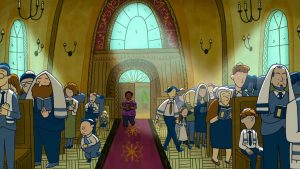Keeping a grip on the thread of hope
Published June 27, 2019
This week’s Torah portion, Shelakh Lekha (Numbers 13:1-15:41), strings together several episodes. The most famous of these is the story of the Twelve Spies.
On God’s command, Moses appoints 12 spies to gather information about the land of Canaan in preparation for the invasion. He wants to know about its fortifications, food sources and the local mood in the face of the incoming mass of people.
The spies return, telling the Israelite community that the land “does indeed flow with milk and honey” but that “the land is one that devours its inhabitants, all the people that we saw in it are giants … and we looked like grasshoppers to ourselves, and so we must have looked to them.”
ADVERTISEMENT
God is enraged that the Israelites, having just witnessed miracles, could be so lacking in faith. God demands punishment and tells Moses that this entire generation will wander the desert for the rest of their lives and only their children will see the Promised Land.
This is followed by another episode of divine wrath: A man is found gathering sticks on Shabbat, is apprehended by unspecified leaders of the community and is held until a divine message about his penalty can be given. God’s command is that he be stoned to death.
Finally, the portion ends with a commandment to add a fringe with a thread of blue to the corners of every garment – the tzitzit that we see on the edges of a tallit or tallit katan. The purpose of this mitzvah is made clear: We will “look at them and be reminded of all the commandments of the Eternal, and do them.”
ADVERTISEMENT
While on their face, these three stories would seem to be unrelated, I believe there is a thread that connects them. The story of the spies is by far the most detailed and outlines the key theme of the parashah. There is a failure on the part of the Israelites, not of faith, but of hope.
The spies state, “We looked like grasshoppers in our own eyes, and so we must have looked to them.” This prompts the community to wish that they had never even left slavery in Egypt. This is not a failure of the people to believe in the power of God to bring about the better future that they want. It is a failure to be able to envision a better future at all.
And God’s response is directly connected to their inability to hope. God says, “Your children, who you said would be carried off, them I will allow to enter, they shall know the land you have rejected.” This is a poignant image of a God who will never stop believing in hope, even when that hope is not shared by God’s people.
Shabbat, too, is a ritual whose core narrative is about hope. David Kraemer writes that the very core of Shabbat demands hope. The work that is prohibited on Shabbat by the rabbis is specifically the work related to producing food, clothing, shelter and written texts — the basic elements of survival.
Shabbat, he writes, “is a time when we pretend that all of the essentials of our survival are already provided to us, a day when we do not have to worry about the struggle of surviving from one day to the next. When, in our remembered history (or in our anticipated future), did we experience such conditions? In the Garden of Eden, then during our sojourn in the desert and finally in the World to Come. … It is a Sabbath that promises not the world that is but the better world that can be.”
Shabbat challenges us to imagine the world as it could be, and to actually try to live as if that world is here.
These two stories tell us about the painful outcome of becoming unable to hope, unable to imagine that things could ever get any better. They are followed by a new commandment. God tells us to begin training ourselves to see more than what is in front of us, to place fringes with a blue strand on our garments. We are to look at the fringes and be reminded of God. The Sfat Emet, a Chassidic commentator, points out that the name for these fringes is very strange: Tzitzit comes from the root tzitz, meaning “to peek” and connects it to a verse from the Song of Songs in which the Divine lover is “peeking between the cracks” at the beloved. This mitzvah is meant to remind us of what is just beyond our sight, and to teach us to cultivate and nurture this kind of awareness every day.
This month is LGBTQ Pride Month, a time when the lesbian, gay, bisexual, transgender and queer communities celebrate and advocate. There is always a careful balancing act. On the one hand, the focus is on the work to be done building justice, safety, dignity and a liveable world for LGBTQ people. Sometimes that work requires a little complaining, a little anger and a lot of awareness of what the world is actually like. On the other hand, the focus of Pride must include hope, imagination and celebration. We need to be able to appreciate just how much more is possible and to imagine the world that we want to build.
Hope needs to be carefully cultivated and built up piece-by-piece. It is that thread of hope that carries us forward.
Rabbi Micah Buck-Yael is the coordinator of community chaplaincy with Jewish Family & Children’s Service and a member of the St. Louis Rabbinical and Cantorial Association, which coordinates the d’var Torah for the Jewish Light.
















